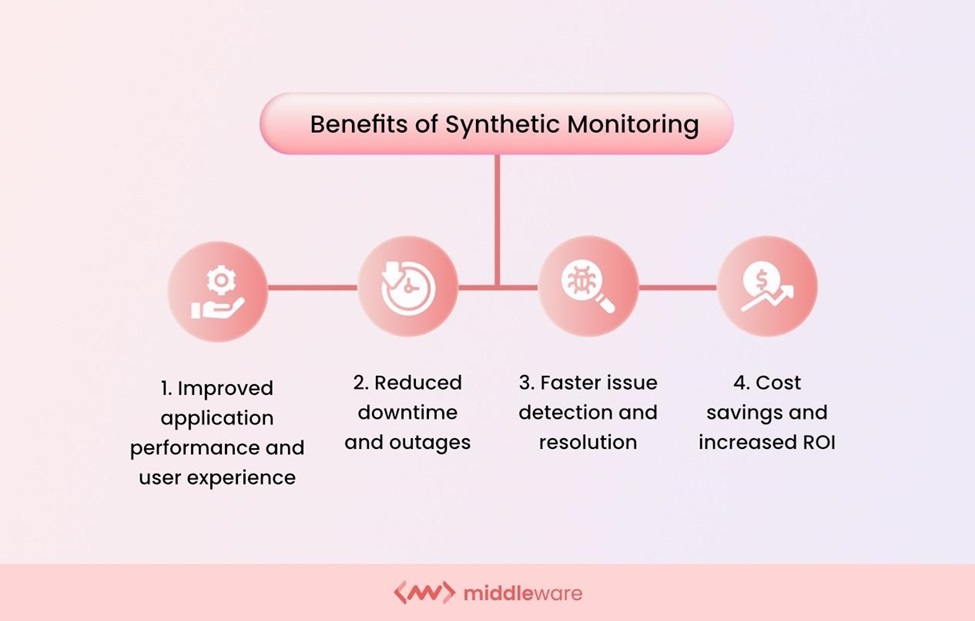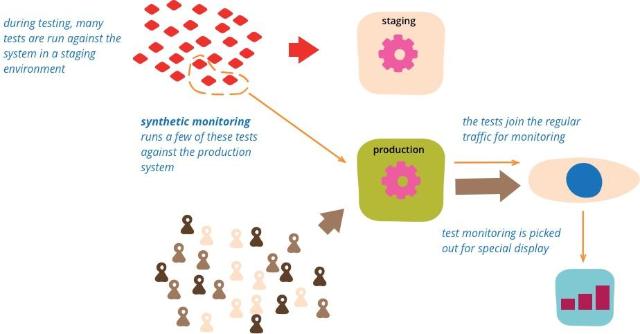Maximizing Cost Efficiency in AWS Cloud Environments: Leveraging Synthetic Monitoring Tools for Real-Time Insights
For companies using AWS, maintaining a competitive advantage and guaranteeing budgetary compliance depend critically on cost efficiency optimization. AWS is a complete cloud infrastructure, providing more than 200 fully featured services from data centers worldwide.
AWS offers machine learning, artificial intelligence, the Internet of Things databases, storage, and processing power. Startups, companies, and government agencies all turn to AWS because of its agility, scalability, and creative edge.
In cloud infrastructure, cost efficiency guarantees the best use of resources, avoiding waste and reducing needless costs. Economic operation scaling allows organizations to accommodate expansion without increasing corresponding expenses.
Encouraging innovation and allowing reinvestment into key business sectors are two benefits of maintaining cost efficiency for a firm. Synthetic monitoring is an essential element of all the ways to do this.
This article explores the features, advantages, and cost-effective implementation techniques of synthetic monitoring in AWS systems.
Understanding Synthetic Monitoring
To continuously track availability and performance, synthetic monitoring simulates user interactions with programs and services. Synthetic monitoring produces simulated transactions to replicate user activity, offering consistent and regulated performance metrics compared to traditional monitoring that depends on actual user data.
Scripts used by synthetic monitoring tools mimic tasks like searching, browsing, and signing in. These scripts offer in-depth information about the user experience and performance of the program.
Types of Synthetic Monitoring
Synthetic monitoring can be broadly categorized into two types:
- Active Monitoring: User behaviors are simulated in order to proactively evaluate application availability and performance. Effective in spotting problems before they affect real users, active monitoring provides a proactive method of performance management
- Passive Monitoring: Passive monitoring records actual user interactions and gathers information about the functionality and user experience of the program. Though it offers real user data, problems might not be found until after they have already impacted consumers
Use Cases in AWS Cloud Environments
Synthetic monitoring has applications in a number of AWS scenarios, such as:
- Application Performance Monitoring: Making sure that web apps housed on AWS perform optimally and provide a smooth user experience
- API Monitoring: Vital for applications depending on API integrations, API Monitoring is the process of confirming the dependability and performance of APIs implemented on AWS
- Service Level Agreements Compliance: Monitoring and reporting of SLA indicators to ensure that contractual commitments are fulfilled
Benefits of Synthetic Monitoring in AWS

Synthetic monitoring in AWS can provide organizations with the following benefits:
1. Cost Savings
- Reducing Resource Waste: Through ongoing service testing and monitoring, businesses can identify areas where resources are unnecessarily being used. Eliminating these inefficiencies can result in significant cost reductions
- Allocating Resources More Effectively: Organizations can obtain a better understanding of usage trends and performance indicators through synthetic monitoring, which provides more precise forecasting and improved resource allocation decisions. For example, by scaling up during high-demand times and scaling down during off-peak hours, resources are employed effectively, and unneeded expenses are avoided
2. Performance Optimization
- Real-Time Detection of Performance Issues: Synthetic monitoring technologies offer real-time application performance statistics, enabling businesses to identify and fix problems early on. By resolving performance issues before they worsen, this proactive strategy reduces downtime and keeps users happy
- Proactive Problem Resolution Before Impacting End-Users: Synthetic monitoring makes proactive problem resolution possible by mimicking user interactions and early identification of any problems. This provides a smoother user experience and keeps AWS-hosted apps reliable by allowing issues to be resolved before they impact end users
3. Enhanced Visibility
- Comprehensive Monitoring of AWS Services and Applications: Synthetic monitoring provides a thorough view of the performance of AWS services and applications. Through ongoing testing and monitoring of every facet of the cloud environment, businesses can get an in-depth view of the performance and health of their infrastructure
- Detailed Reporting and Analytics: Synthetic monitoring tools give insightful reports and analytics that shed light on performance patterns and abnormalities. These insights allow businesses to make choices about cost control, performance enhancement, and resource allocation
Key Synthetic Monitoring Tools for AWS
Organizations can implement the following tools to harness the benefits of synthetic monitoring:
AWS Native Tools
AWS CloudWatch Synthetics is a native AWS service that allows users to create canaries, which are scripts that run at regular intervals to monitor application endpoints and APIs. These canaries simulate user actions to provide insights into application performance and availability.
Features and Benefits of Using AWS-Integrated Tools
- Seamless Integration: As a native AWS service, CloudWatch Synthetics integrates seamlessly with other AWS services to offer a unified monitoring solution
- Customizable Canaries: Users can customize canaries to simulate specific user actions and monitor different endpoints
- Comprehensive Reporting: CloudWatch Synthetics provides detailed reports on application performance, which help identify issues and optimize resources
Third-Party Tools
Several third-party tools offer synthetic monitoring capabilities for AWS environments. Tools like Middleware, Dynatrace, Datadog, and New Relic provide advanced features and integration capabilities that improve the monitoring experience.
Comparison of Features and Integration Capabilities with AWS
- Middleware : Provides extensive analytics, real-time warnings, and configurable dashboards, among other powerful monitoring tools. Integrating Middleware with AWS provides a comprehensive monitoring solution
- Dynatrace: Distinguished by its automation and AI-driven insights, Dynatrace provides powerful synthetic monitoring features. It provides end-to-end visibility into application performance by integrating with AWS
- Datadog: Datadog provides synthetic monitoring, real-time alarms, and in-depth analytics. Its smooth connection with AWS allows users to manage all of their cloud infrastructure from a single interface
- New Relic: New Relic provides complete performance reports, real-time alarms, and customizable scripts, among other sophisticated synthetic monitoring tools. Well-integrated with AWS, New Relic acts as a single monitoring solution
Implementing Synthetic Monitoring in AWS
Follow these steps to begin using synthetic monitoring in AWS:
- Choose the Right Tool: Consider the various synthetic monitoring tools that are available and choose the one that suits your requirements. Those who would like to use AWS-native solutions could start with AWS CloudWatch Synthetics
- Create Canaries or Scripts: Install canaries or scripts to watch application endpoints and mimic user behavior. Personalize the scripts to represent actual user exchanges
- Schedule Monitoring Intervals: Sort the monitoring intervals according to the usage patterns and criticality of your application
- Configure Alerts and Notifications: Create alerts and notifications to get performance issue updates in real-time. Check that alerts are set up to notify the appropriate teams for quick response
- Review and Analyze Reports: To find performance patterns and areas for development, routinely go over the reports produced by the monitoring tools
Configuring Alerts and Dashboards for Real-Time Insights
- Alerts: Configure alerts for availability, mistake rates, and response times—among other important performance indicators. Make sure the right teams receive actionable alerts
- Dashboards: Build bespoke dashboards to show application performance in real-time. Utilize these dashboards to keep an eye on important performance measures and spot problems early
Synthetic Monitoring Best Practices
Follow these practices to ensure a successful synthetic monitoring experience:
1. Regularly Reviewing and Updating Monitoring Configurations
Update and evaluate monitoring settings often to make sure they represent the performance needs and usage patterns of the application.
Modify the monitoring settings according to the changes in user behavior, application architecture, and business needs.
2. Combining Synthetic Monitoring with Other Monitoring Techniques
For complete visibility, combine synthetic monitoring with additional monitoring methods, including infrastructure and real user monitoring (RUM).
Take a comprehensive approach to monitoring that includes infrastructure health and application performance.
Common Challenges and Solutions
Let's look at some challenges organizations may face while implementing synthetic monitoring, and how to overcome them:
- False Positives: Synthetic monitoring can sometimes generate false positives. Refine monitoring scripts and thresholds to lessen the chances of this occurring
- Script Maintenance: Maintaining and updating monitoring scripts on a regular basis will help to guarantee that they accurately represent user interactions and current application capabilities
- Realistic Simulations: To receive correct performance insights, make sure synthetic monitoring scripts mimic genuine user interactions
- Continuous Improvement: Use performance statistics and comments to routinely examine and improve monitoring setups and scripts
Measuring the Impact
Use the following metrics to track the operations of your organization:
1. Key Performance Indicators to Track Cost Efficiency Improvements
- Resource Utilization: Measure resource use to find underused resources and maximize distribution
- Response Times: Track response times to make sure apps are working as expected
- Error Rates: Track error rates to quickly spot and fix performance problems
- Cost Savings: Total up the savings brought forth by better resource distribution and less downtime
- Performance Improvements: Track gains in user experience and application performance brought about by early problem resolution
2. Continuous Improvement
Consider the following strategies to foster ongoing optimization:
- Regular Audits: To find areas that need work and make the necessary adjustments, audit the cloud environment frequently
- Feedback Loop: Get ideas from monitoring data and always improve monitoring techniques by setting up a feedback loop
- Data-Driven Decisions: Make wise choices about cost control, performance enhancement, and resource distribution by using monitoring data
- Iterative Approach: Use an iterative approach to monitoring, always improving setups and tactics in response to performance data and user input
Conclusion
Improved cost-effectiveness in AWS systems is largely dependent on synthetic monitoring. Providing proactive performance management and real-time insights, synthetic monitoring solutions enable businesses to maximize resource use, cut operating expenses, and enhance overall service delivery. Insights from synthetic monitoring in real time let companies ensure a smooth customer experience and quickly fix performance problems.
The significance of synthetic monitoring will grow as cloud settings do. Organizations will be able to attain even higher degrees of cost-effectiveness and performance optimization with developments in monitoring technology and integration capabilities.
To keep ahead of the curve and drive continuous improvements in their AWS environments, companies are encouraged to integrate synthetic monitoring technologies in their cloud management plans.
Author Bio: Ashwini Dave
Ashwini Dave is an accomplished digital marketer specializing in SEO and groundbreaking campaigns. With an MBA in Marketing, she crafts strategic, high-impact results. A tech enthusiast exploring AI and cutting-edge tech, Ashwini seamlessly integrates innovation into her marketing strategies. Outside the digital sphere, she is an avid traveler, finding inspiration in nature's beauty while exploring the world.

